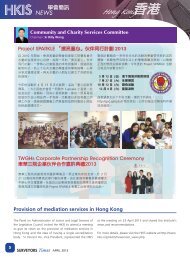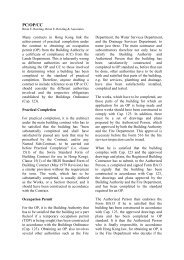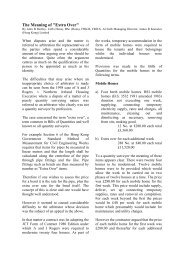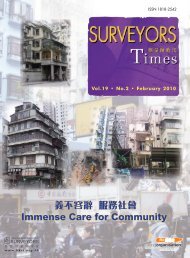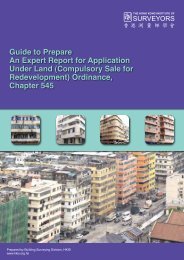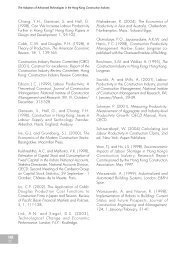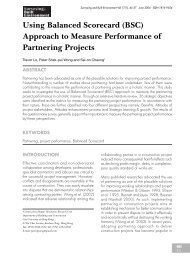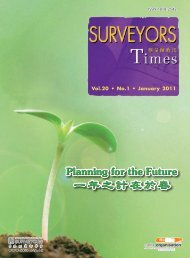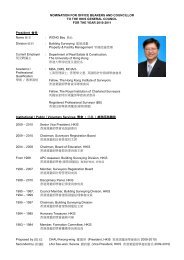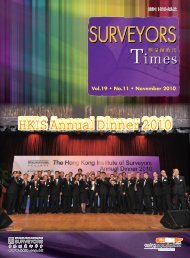Surveying & Built Environment Vol. 22 Issue 1 (December 2012)
Surveying & Built Environment Vol. 22 Issue 1 (December 2012)
Surveying & Built Environment Vol. 22 Issue 1 (December 2012)
You also want an ePaper? Increase the reach of your titles
YUMPU automatically turns print PDFs into web optimized ePapers that Google loves.
The results show that an affine<br />
transformation with a high degree<br />
of freedom of control points can<br />
achieve a better result than a similarity<br />
transformation in direct DD Sheet georeferencing<br />
(‘Pattern A’ & ‘Pattern C’).<br />
However, such positional accuracy is far<br />
from sufficient to cope with the current<br />
centimetre-level positioning accuracy<br />
requirement for land development.<br />
If the DD Sheet’s function as a lease<br />
plan is interpreted solely on its graphic<br />
presentation, an average error at about<br />
4 metres is likely to be what we get<br />
(Zhang & Tang, <strong>2012</strong>). After all, it<br />
reflects a good internal accuracy of the<br />
1:3960 DD Sheet such that 1 millimetre<br />
of error on the map represents 4 metres<br />
on ground.<br />
The main shortcoming of this direct<br />
georeferencing method is in the case of<br />
a lack of long-lasting (between 1905<br />
and nowadays) stable features. So, only<br />
if several long-lasting stable features<br />
are evenly distributed in the subject<br />
area, can this direct georeferencing<br />
method be useful.<br />
INdIRECT CooRdINATE<br />
fIXING – oRTHopHoTo<br />
CoRRElATIoN<br />
A correlation using the detailed survey<br />
plan and the DD Sheet has been the<br />
traditional method for obtaining land<br />
parcel coordinates. With the availability<br />
of large scale survey sheets, the New<br />
Territories Administration has made<br />
good efforts at correlating the DD<br />
Sheet. It allowed small modifications to<br />
the DD Sheet according to then-existing<br />
features.<br />
(a) Any line which follows the same<br />
general shape as the original<br />
<strong>Surveying</strong> and <strong>Built</strong> <strong>Environment</strong> <strong>Vol</strong> <strong>22</strong>, 74-87 Nov <strong>2012</strong> ISSN 1816-9554<br />
may be accepted if the average<br />
dimensions of the lot do not vary<br />
from the original by more than<br />
+/- 2% or +/- 5’ (whichever is<br />
the greater) and if the area when<br />
compared with the original is<br />
within the limits laid down by<br />
Instruction No. 20.<br />
(b) Reorientation of a lot by rotation<br />
depends on its situation. Isolated<br />
lots may be rotated until the<br />
best fit is obtained, but when in<br />
groups, each and every lot must<br />
be considered. (Empson, 1969)<br />
The current boundary layers of the<br />
Cadastral Information System of the<br />
HKSAR Government are very much<br />
inherited from survey plan and DD<br />
Sheet correlation work in the 1980s for<br />
which the product “Green Key” was<br />
produced with correlation rules that<br />
affirmed long-time peaceful occupation.<br />
3. The overriding consideration is<br />
that the original DD boundaries<br />
were in fact Lines following<br />
ground features. Whilst their<br />
planimetric positions may not<br />
be reliable, their "occupationdependent"<br />
nature must hold<br />
true. It therefore follows that<br />
details shown on the current<br />
survey sheet which appear to<br />
be features surviving over the<br />
years and resembling the DD<br />
boundaries, must be adopted for<br />
correlation to be put into effect.<br />
(Leung, 1987)<br />
Correlation invariably produces slightly<br />
amended and improved versions of the<br />
land boundary record as compared to<br />
the original lease plan. The updated<br />
boundary record is needed by the<br />
government for daily administration as<br />
SBE<br />
79



